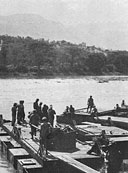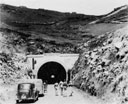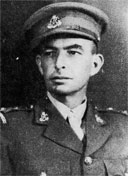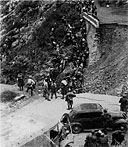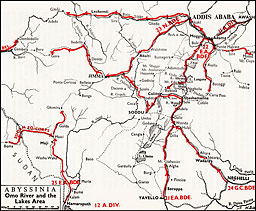
21
The Battle of the Lakes--Soddu
Mopping up was still proceeding in Italian Somaliland when Lieutenant G. Barton-Bridges's section of 9th Field Company, S.A.E.C. had to put in four days of back-breaking work salvaging pontoons of the Yonte bridge, which was wrecked when an Italian 10-ton truck and 8-ton trailer overturned into the river. By mid-April the bridge was being dismantled and moved to Lugh Ferrandi by 73rd East African R.M.T. Company. On the eve of launching the bridge at this new site, the South African company suffered its only fatal casualty of the campaign when the cable of the existing Italian ferry parted and the pontoon sank.
Sapper R. B. Wilson, the strongest swimmer in the party on the pontoon when it broke away, had been selected to help the only non-swimmer, Sapper L. T. Jones, but Wilson disappeared almost immediately the pontoon sank and he was not seen again. Sapper Jones was brought ashore 180 yards downstream by the courageous action of Corporal J. A. Martin, Lance-Corporal W. E. Middleton and Sappers G. A. Stubbs and B. G. Veronie, the last-named being awarded the British Empire Medal for his outstanding part in the rescue.
Disaster was to overtake the newly launched bridge, for torrential rain fell during the night after its opening to traffic on 27 April, the river rose 4 feet in forty minutes and the main suspension cable broke under the strain of hundreds of tons of debris carried down by the 6|-mile-an-hour current.
Six days of arduous effort was needed to get a rope across the Juba, which had widened from 370 to 425 feet at Lugh Ferrandi. Clamps on the original 58-inch rope broke and it was only saved by Lance-Corporal F. A. Humphreys grabbing the loose end, turning it round one of the achorages and holding on, with the palm of his hand cut to the bone. In the end, a ferry had to be installed with the approval of Brigadier Minnis1--but that still left the Dawa Parma River to be crossed only 40 miles to the north-west at Dolo, where the old Italian bridges had also succumbed to the floods and likewise had to be replaced by a ferry.
In spite of such adverse conditions, 12th African Division continued its laborious push up from Yavello and Neghelli with 21st East African and 24th Gold Coast Brigades respectively.2 Spread over a front of nearly 300 miles, from Neghelli westward to Maji, was No. 1 S.A. Armoured Car Company.3
